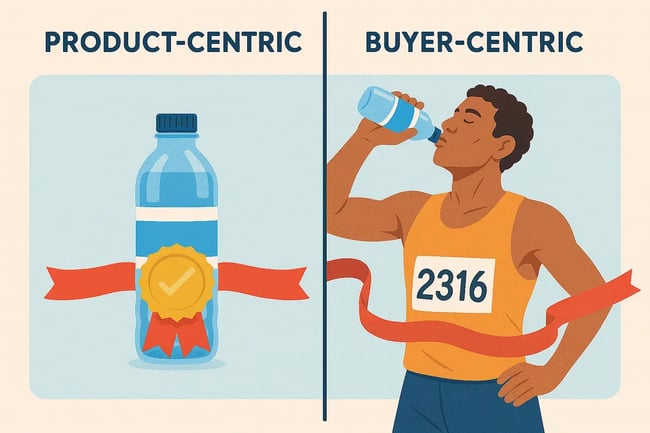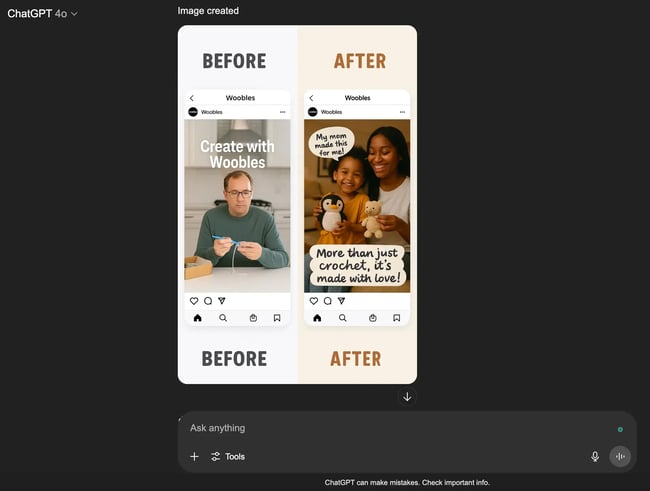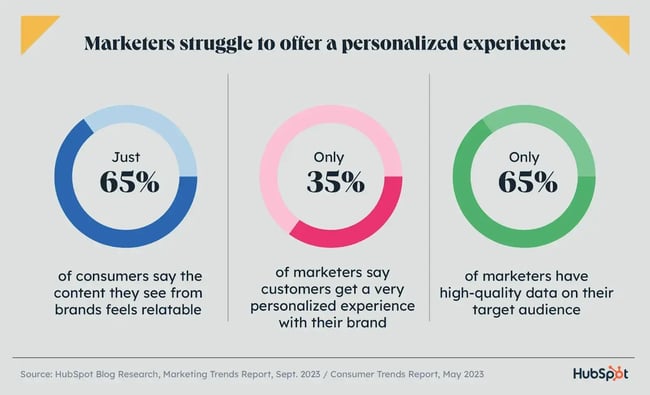Marketing is a paradoxical undertaking: We create campaigns for the masses, but those messages are only ever experienced on the individual level. How does a good marketer straddle this? By writing directly to a single viewer, aka their buyer persona.
The definition of a buyer persona hasn‘t changed much in recent years. But the trends have, and so has the opportunity that AI presents. I love creating personas: I’ve used them while working for nonprofits, government offices, online businesses, ecommerce products, and more.
As a consumer, I observe marketing materials in the wild and try to put my finger on who they were targeting and if their messaging was effective. Let’s dive into a brief buyer persona definition, then examine the benefits and opportunities at our fingertips (examples included!).
Table of Contents
- What is a buyer persona?
- 7 Buyer Persona Benefits
- Where AI Fits In
- Best Practices for Creating Buyer Personas
Using market research and real customer data, companies will create multiple buyer personas that reflect diverse user groups and different points of the customer journey. A detailed buyer persona will guide product development, marketing campaigns, and provide cross-team alignment.
Ready to put this definition into practice? Create a detailed buyer persona for your business.

What is a negative buyer persona?
Most buyer personas are positive, meaning that they focus on who a brand wants to attract. At times, it‘s beneficial to reverse-engineer this process and focus on who isn’t the right fit for the brand.
Here‘s an example of a negative persona that I created with HubSpot’s free persona templates. I designed the fictional character Premed Isabella as a negative persona for a rural medical school. The school (inspired by my alma mater) specifically wants to attract premed students with a passion for rural medicine and underserved communities.
Premed Isabella is an impressive candidate, but she doesn‘t align with the school’s mission of treating the rural healthcare crisis. This is apparent in the technology/social media and goals/motivations section of Premed Isabella’s persona profile:

I cover this buyer persona example in more depth (plus share seven more examples) in this guide.
My advice: Not every marketing strategy needs a negative persona. Start here if you‘re feeling stuck on developing your positive personas. Deciding who doesn’t fit as your target audience can help you clearly see who does.
7 Buyer Persona Benefits
Why are buyer personas important? These seven benefits speak for themselves.
1. Centers Customers
Marketing teams self-sabotage when they make their product the hero of the story. The real hero is the customer, and your brand acts as a guide on their journey to success. This is famously referred to as the hero’s journey, and it‘s something that’s covered in every introductory marketing class.
If it’s so foundational, why is it so easily forgotten? Many businesses become brand obsessed instead of customer obsessed. By creating detailed buyer personas and using them as a compass, marketing teams recenter the customer.
It shifts the conversation from “how do we sell our incredible water?” to “how do we sell our water to the incredible Water Walter?” Water Walter is a quick customer persona I drew up using ChatGPT. You can see the contrast of this approach:

My advice: Use your persona’s first name (like Walter) in internal emails, campaign brainstorming, etc., to reinforce this character in your marketing efforts.
2. Sharpens Copywriting
The most effective copywriting feels like it’s looking a customer dead in the eye, not mumbling and avoiding eye contact. Defining buyer personas doesn’t automatically achieve the former. But developing every marketing asset for one of them does.
I often see companies use vague, untargeted copywriting. Here are three examples of common copywriting flops and how I edited them to focus on one buyer persona.
- Pregnancy test company:
- ❌ We know that some of you hope you‘re pregnant, and some of you hope you aren’t.
- ✅ By your side, whether you’re hoping for plus or a minus.
- Used car dealership:
- ❌ This is for all our customers who feel overwhelmed by buying a car.
- ✅ I know you feel overwhelmed by car shopping.
- Software provider:
- ❌ You guys asked for this new feature, and we finally have it ready.
- ✅ You asked — and you were spot-on!
Feel the difference? These language tweaks remove the distance between you and the customer.
My advice: Never use plural pronouns to describe your target customer (and minimize them when talking about your brand). Speak to one individual person every time, like this sample Grammarly ad ChatGPT generated for one of my persona examples.

3. Aligns Teams
Sales, marketing, customer support, and leadership should all have a unified understanding of customers and products. Depending on company size and product complexity, this can be a big internal hurdle. Personas of both potential and existing customers will give the internal teams a shared language and vision.
This is an ongoing, circular effort: Align on the target audience personas. Accrue data. Align around that data (learn how here). Meet regularly to identify patterns.
Here’s an example of a fictional persona I made for the crochet kit company The Woobles, named Woobles Whitney. Using HubSpot’s free persona templates, I built marketing messages directly into the document to ease the handoff between teammates.

4. Leads to Highly Relevant Content
Detailed buyer personas describe the ideal audience as it relates to the product. This connection between customer and product should be crystal clear so marketing can create the most relevant messaging possible. This might sound obvious to founders or career marketers, but it gets overlooked.
For example, I once consulted with a menstrual cup company on their content marketing. They had outlined their ideal buyer persona as a 20 to 45-year-old, trendy, active woman who lived in New York City and loved eating out, traveling, going to clubs, etc.
What was this persona card missing? Specific pain points as they relate to the product: it was missing menstruation. A woman could meet all of the listed points but be on birth control that stops her period, and therefore, she’s not going to convert into a customer.
Remember my persona, Woobles Whitney? I asked ChatGPT to create two fake Instagram ads: one that was generic, and one that targeted Woobles Whitney. Here’s what ChatGPT made me:

Relevant content is the stepping stone to the next benefit: personalization.
5. Creates Personalization Opportunities
I just scrolled on LinkedIn for 10 minutes trying to find an ad that was personalized to me. What did I find? Nothing. It‘s possible — I’ve seen many ads on LinkedIn in the past targeting people who work for HubSpot. I’ve even seen ads on Pinterest so personalized that they included my name.
It was for a sweatshirt that said “You wouldn’t understand, it’s an Ihrig thing” (Ihrig being my last name). The first time I saw this, my eyeballs popped out of my head like in an old cartoon. Imagine how much ad spend the company would’ve wasted by showing that ad to people with the last names Gould, Fanty, or Huffman.
Personalization is both an old-school sales strategy and a surging trend. In our 2025 State of Marketing survey, 96% of marketers said that personalized experiences have increased sales. Yet many of them struggle to create personalized experiences.

Once you gather data (through your website, social media, CRM, etc.), creating content targeting specific customers or pain points is a lot of fun. The image below was produced on an episode of Marketing Against the Grain, where HubSpot CMO Kipp Bodnar showed how he’s toying with AI to create one-of-one, hyper-personalized ads (see more here).

6. Boosts Brand Loyalty
The personalization trend leads directly to brand loyalty. According to Content Square’s 2025 Digital Customer Experience Trends, 78% of consumers say personalized content makes them repurchase from a brand.
Creating tailored marketing messages is only the tip of the iceberg. Great brands are able to understand their ideal customers’ desires and know how to delight them. This may sound vague, but look at brands or entrepreneurs that do this well: Disney, LEGO, Trader Joe’s. The level of customer loyalty has risen to the point of fandom.
Even on its 404 page, LEGO has fun with its customers:

Buyer personas aren‘t new, and neither is the urge to improve customer loyalty. So why isn’t everyone doing this well? It‘s time-consuming, expensive, and some brands won’t be around long enough for this to manifest.
My advice: Get investigative about this process from the other side. Find a brand in your life that you feel a loyal connection to and examine how their marketing efforts have facilitated that.
7. Lowers Costs
All of these factors manifest into more efficiently spent budgets. You can draw a direct line between understanding your customer and making more sales. Campaigns, landing pages, and emails convert at higher rates. Ad spend goes further. In the marketing world, successful persona creation = a better use of budget.
Where AI Fits In
Ready to create a buyer persona that leverages AI? The power at your fingertips is massive. Our research found that 73% of marketers feel AI can help them be more productive at what they do.
In terms of personas, AI makes it possible to analyze massive amounts of data in real time. We‘ve all heard this — here’s exactly how it comes to life.
- Analyzing data: There’s an incredible amount of data sleeping inside your support tickets, Google Analytics, CRM, etc. Try to analyze it yourself, and your job will never be done. Use AI to make the data actionable by highlighting trends and opportunities. Train a custom AI knowledge base for each persona, and you can ask it to suggest demographic segmentation, seasonal opportunities, etc.
- Generating multiple personas: Most businesses need multiple personas. How many buyer personas should a business have? You should start with one: your most common customer at the top of your funnel. Creating these manually is tedious, but AI makes this approachable, as you can use each persona as the template for the next.
- Creating personalized experiences: AI can analyze past behavior at an individual level, creating recommendations that are hyper personalized. This is especially useful for online platforms with large quantities of products such as bookstores, music stores, or online shopping. A great example of this is Spotify’s recommendations based on your most listened-to playlists.
- Making routine updates: Feed your AI models with new data, and you can get automatic real-time updates to your customer personas. This doesn’t mean make your persona a set-it-and-forget-it marketing task. Some changes with your target market will only be caught through human observation, but AI can focus on the micro while you focus on the macro.
What AI Needs to Succeed
If you‘re reaching for ChatGPT to avoid gathering real data on your customers, you’re setting yourself up to create generic personas. AI should be used to enhance your buyer persona research, not replace it. Data and human understanding of your consumer and product are still essential ingredients.
All of this data should come together to create a unified view of your customer. This should be the goal of any tool that you use to gather data on your customers or leads. It’s the focus of the HubSpot Smart CRM, where our AI system helps 59% of HubSpot users have a more unified view of their customers versus non-HubSpot users.
Best Practices for Creating Buyer Personas
Excited? Let these best practices guide your persona generation. These apply whether you’re creating campaigns yourself or prompting AI to do it for you.
- Include demographic information: Fundamentals like job title, age, income, family, education, etc. (get a conclusive list of persona research points here).
- Observe their behavior and feelings: What are their preferred information channels? Behavior patterns? Motivations? Goals? Fears? You can only create content that‘s personalized when you understand who you’re talking to and what their desires are.
- Aggregate all of the data possible: Customer insights are lurking in your website analytics, product reviews, customer feedback, support tickets, etc.
- Consider the customer journey: Effective buyer personas evolve as the customer moves through the buying process. Top of funnel concerns are different from bottom of funnel concerns.
- Weigh generational trends: Age can be an arbitrary number, but grouping customers based on generation helps you understand shopping trends and preferences.
- Ask your customer base for insights: Companies with big budgets can pay for focus groups. Smaller marketing teams can invite happy customers to do surveys or open-ended customer interviews.
- Update personas regularly: Your customers are changing constantly. Routinely evaluate if your persona is still accurate or if new trends, data, customer feedback, touchpoints, etc. can enhance your company’s buyer persona.
Every successful buyer persona represents hours of thought and care, and we can help expedite the process with our free templates.
Ready to make a persona for your marketing and sales teams? Use our video tutorial below as a guide, plus download our free templates or use our self-guided persona generator to make progress right away.
Get obsessed with customer personas.
A good buyer persona is going to give your entire team a better understanding of the customer, help them create better content that improves the customer experience, and help potential customers along in their decision-making process. It’s a win for everyone.
![]()
from Marketing https://ift.tt/XKtOQsP
via IFTTT

